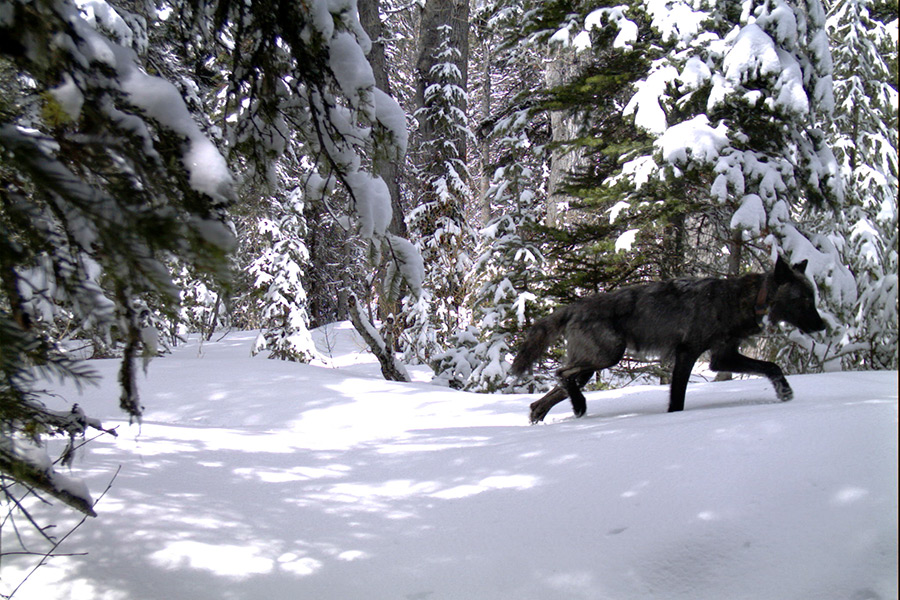A Thompson Falls legislator has introduced a pair of bills that would allow hunters to kill wolves at night and permit trapping the animals along seasonally closed roads.
Republican Rep. Bob Brown said he introduced the measures because his constituents in Northwest Montana have been advocating for nighttime wolf hunting and expanded trapping opportunities due to the impact they say wolves have had on deer, elk and moose populations in Sanders County hunting districts.
It’s been a point of contention this legislative session as a host of bills aimed at reducing wolf numbers crowd the docket, with Brown’s name attached to many of them. Last week he brought House Bills 551 and 552 before the House Fish, Wildlife and Parks Committee, which he chairs.
The bills received support from two people who testified that they would provide additional tools to manage the wolf population, while leaders of several conservation groups opposed them, calling the nighttime wolf-hunting proposal “unethical,” and raising concerns about trapping along seasonally gated roads due to the level of use they receive from skiers, hikers and dog-walkers.
“We feel hunting any game animal at night is unethical,” Nick Gevock, of the Montana Wildlife Federation, told the committee members while testifying in opposition to House Bill 551.
Montana Fish, Wildlife and Parks, the agency tasked with managing the state’s wolf population, also opposes the bill, saying it could intensify poaching at night, which often involves the use of spotlights.
If passed, the bill would make wolves the only big game animal that could be hunted during non-daylight hours.
The second bill, House Bill 552, would remove setback regulations on roads closed to highway vehicles year-round, and would also make them inapplicable on gated roads closed seasonally. Current trapping regulations require a “setback,” or a specific distance away from roads and trails that traps must be set.
Traps for most animals are required to be set 50 feet from a road or trail, but wolf traps require a 150-foot setback.
Art Compton, a member of the Montana Chapter of the Sierra Club, said gated roads are a go-to destination for skiers, snow-shoers and dog walkers looking to avoid motorized use, and trapping setbacks serve as a buffer for both humans and canines.
KC York, the founder and executive director of Trap Free Montana, held a sign bearing the message “Traps hold our public lands hostage.” She said the state’s setback regulations were carefully designed to accommodate the non-trapping public who also travel on public lands.
Brown said it was incumbent upon pet owners and other public land users to take responsibility in areas where trapping is allowed, and also noted that nongame animals like coyotes and skunks can be legally hunted at night.
The committee hearing came on the heels of several recent meetings that drew hundreds of hunters and trappers from Brown’s district who say wolves are overrunning the deer, elk and moose populations.
Although biologists and wildlife experts with Montana Fish, Wildlife and Parks acknowledge that predators like wolves have an impact on ungulate populations, they say other factors contribute to fluctuating hunting harvests, including habitat changes caused by timber management and wildfire, as well as back-to-back heavy winters.
Recent population estimates peg Montana’s wolf population at about 850 animals statewide, with about 350 living in this region, which FWP defines as Region 1. The state wolf management plan allows for what officials describe as a lax hunting season as long as the population stays above a minimum 150 wolves.
If Montana were to hit that number, it would trigger a federal review by the U.S. Fish and Wildlife Service, which could return wolves to protection under the Endangered Species Act, effectively ending wolf hunting. But most of the hunters in the room encouraged state wildlife officials to manage for that minimum population objective.
This hunting season, the state has sold about 17,000 wolf licenses. That’s down from 2013, when wolf hunters bought 24,000.
Another one of Brown’s wolf-related proposals, House Bill 280, would add wolf tags to combination sportsman licenses that include black bear, deer, elk, upland bird, and fishing. Brown says such a bill would apply to residents and non-residents and would boost the number of license holders. Another measure, House Bill 279, would reimburse licensed wolf trappers for their costs — a proposal that critics have likened to a state-sanctioned bounty, which is illegal in Montana.
Last year, 24,217 Montana resident hunters bought a $70 sportsman’s combination package that included tags for deer, elk, upland gamebirds and fishing. Another 19,226 bought the same package with a bear license included for $85. HB 280, if amended, would add a wolf license to that for an additional $10. Individual wolf licenses cost $19.
During the 2017-18 season, hunters and trappers took 254 wolves, with 166 by hunters and an additional 88 by trapping. Total wolf mortality was about 305 wolves.
